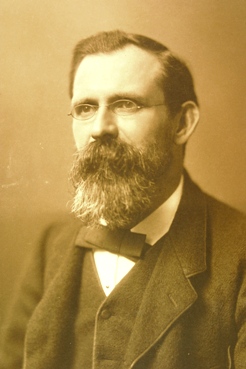
The Ordovician System and Period was the solution proposed by Lapworth
9 (picture) in 1879 to end the problem over the position of the boundary between the Cambrian and Silurian Systems. The dispute about the boundary had made enemies out of Sedgwick and Murchison who founded the two Systems, and Lapworth’s solution was gradually adopted by most of the world. Even the word "Ordovician" provided a deft compromise, for the country of the Ordovices lay to the north of that of the Silures and south of Cambria, or north Wales.
Despite international adoption problems remained, and the Geological Survey of the UK persisted until the 1990s) to treat the oldest of the British Ordovician Series, the Tremadoc, as Cambrian – following the line of chief palaeontologist, and later Director, Sir James Stubblefield. The faunas of the Tremadoc Series are unquestionably, however, of Ordovician rather then Cambrian affinity.
Subsequent attempts at refinement by subdividing the Ordovician into Series turned increasingly to time-correlations based on guide-fossils. Thus during the latter part of the 19th Century and into the first half of the 20th, the British Ordovician was split up into six Series: in ascending order Tremadoc, Arenig, Llanvirn, Llandeilo, Caradoc and Ashgill – some of which go back to Murchison. The first four were named after Welsh type localities, the fifth after the Welsh Borderland (South Shropshire) and the final one after a locality in the English Lake District. Their faunas were systematically collected and described in a series of important papers and monographs that spanned most of the 20th Century and further subdivided into Stages as knowledge developed.
Early on it became apparent that there were considerable differences between supposedly coeval faunas from different parts of the world. With the advent of plate tectonics came the idea of "allochthonous terranes", which made it easy to understand why faunas in, for instance, the North-west Highlands of Scotland, differed from those in Girvan (Southern Uplands), and why these, in turn, differed from those of England and Wales. In other countries separate schemes of Ordovician Series were built up. In North America the System is divided into Ibex, Whiterock, Mohawk and Cincinnati Series; while different (but chronologically parallel) schemes are used in Scandinavia and China because of faunal differences.
Nevertheless it remained possible to correlate from one faunal province to another by using the planktic graptolites and conodonts. Admittedly these correlations were approximate; but enough was known to recognise, for instance, that the base of the North American Ibex Series was older than that of the Tremadoc. In other words, for practical convenience, a different Cambrian-Ordovician boundary was in use in North America from that recognised in Britain.
References cited
- McLaren, D. J. 1977. The Silurian-Devonian Boundary Committee. A final report. In Martinsson, A. (ed.) The Silurian-Devonian Boundary. Schweizerbart, Stuttgart, 1-34.
- Webby, B. D. 1994. 1994. Chairman’s Report. Ordovician News, 11.
- Fortey, R. A., Harper, D. A. T., Ingham, J. K., Owen, A. W., Parkes, M. A.,Rushton, A. W. A. & Woodcock, N. H. 2000. A revised correlation of Ordovician rocks in the British Isles. Geological Society, London, Special Reports, 24, 83 pp.
- Bergström, S. M., Löfgren, A. & Maletz, J. 2004. The GSSP of the Second (upper) Stage of the Lower Ordovician Series: Diabasbrottet at Hunneberg, Province of Västergötland, southwestern Sweden. Episodes, 27, 267-272.
- Bergström, S. M., Finney, S. C., Chen Xu, Goldman, G. & Leslie, S. A. 2006. Three new Ordovician global stage names. Lethaia, 39, 287-288.
- Cope, J. C. W. 1993. High resolution biostratigraphy. In Hailwood, E.A. & Kidd, R.B. (eds) High resolution stratigraphy. Geological Society, London, Special Publications, 70, 257-265.
- Callomon, J. H. 1995. 1995. Time from fossils: S.S. Buckman and Jurassic high-resolution geochronology. In: Le Bas, M. J. (ed.) Milestones in geology. Geological Society, London, Memoirs, 16, 127-150.
- Cope, J. C. W. 1996. The role of the Secondary Standard in stratigraphy. Geological Magazine, 133, 107-110.
- Lapworth, C. 1879. On the Tripartite Classification of the Lower Palaeozoic rocks. Geological Magazine, 6, 1-15